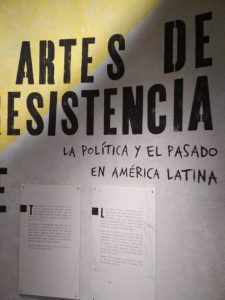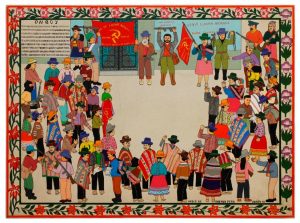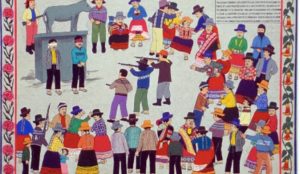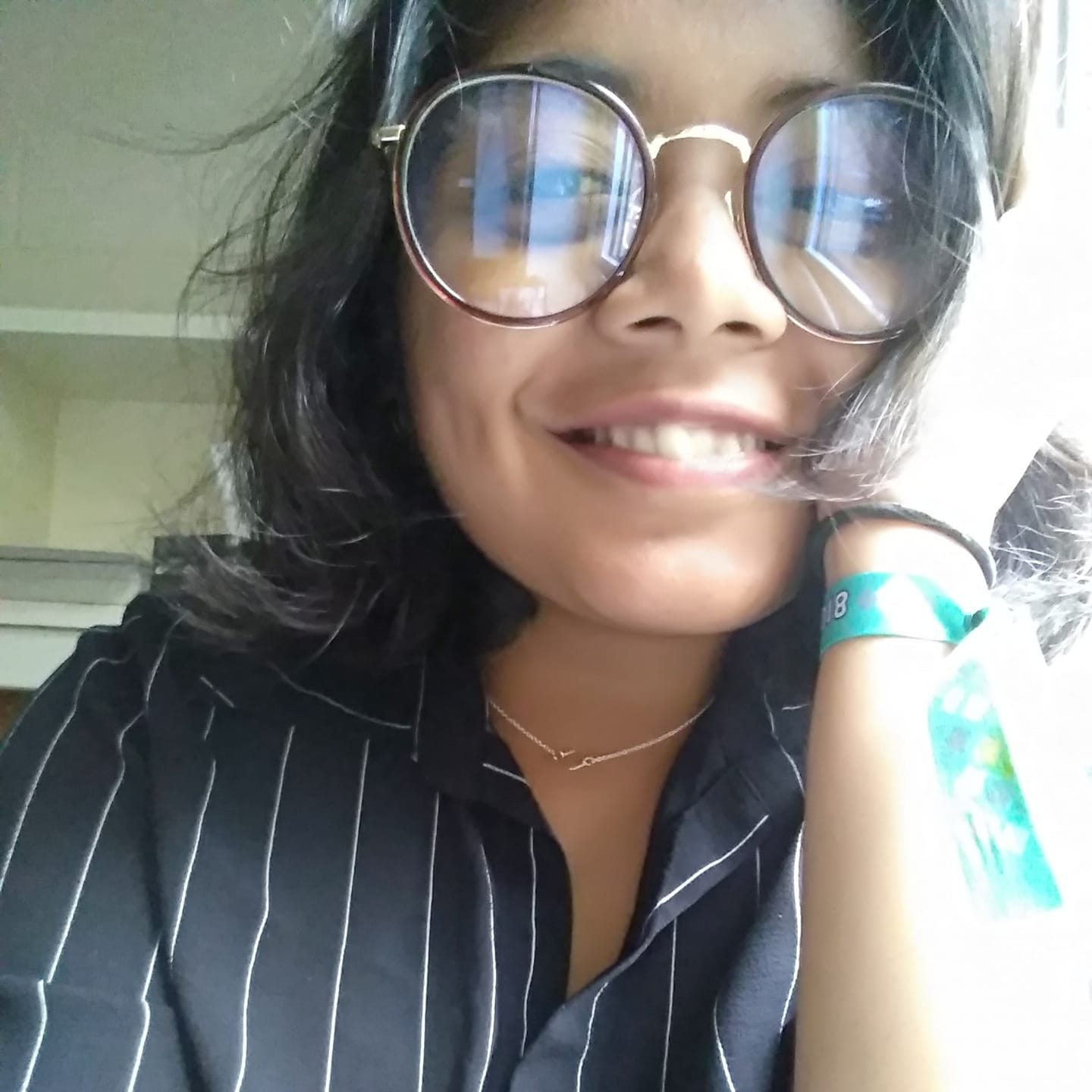
Recently, I had the wonderful opportunity to visit the Museum of Anthropology (MOA) with some of my peers in Global Citizens to see an exhibition called “Arts of Resistance” which displayed various artistic mediums that represented the difficult lives of “marginalized communities” and how they used art to show those “times of political turmoil” (Arts Of Resistance, MOA).

One such display was the “Piraq Causa [Who Is To Blame?]”. This particular exhibit brought me back to the idea of how visual forms of life narratives can so broadly capture the story of ones lives in simple ‘cartoon-ish’ paintings but also leave “gaps” for that which we are to assume. It was much like reading Persepolis.

A painting from the series “piraq causa”. Source: http://dispersionyserendipia.net/articulos/piraq-causa-una-memoria-de-los-irrepresentables/

Source: Association of Popular Artists of Sarhua, https://altavoz.pe/2018/01/25/92319/piraq-causa-quien-es-el-culpable-esta-es-la-secuencia-completa-de-imagenes-acusadas-de-proterroristas/
Tablas pintadas (painted boards) was a traditional way of documenting everyday life activities of the Sarhuino community living in the region of Ayacucho (Sørensen, “Journal of the Society for Latin American Studies”). After the insurgence of the “Shining Path” (a guerilla fighting communist group), some Sarhuinos documented a sort of testimony of twenty-four such tablas pintadas which they named “piraq causa” which roughly translates to “Who Is To Blame?”
When the “Shining Path” first entered Ayacucho, Peru, they were able to win the people’s support. This was primarily because the indigenous communities were very much overlooked by the government, often conquered by more powerful colonizing groups. However, the Peruvian government soon took charge against the revolutionary movements of the guerrilla fighters and eventually it was the people of Peru who got caught in between in the conflict. Hence, the name of the series literally asks, “Who Is To Blame?” because the Sarhuino survivors wonder: Are they to blame for supporting a side in the first place? Is the government to blame? Or perhaps the “Shining Path”? (Sunnucks)

The “piraq causa” series can also be related back to something I learned in Sociology 100 called the “Conflict Theory”. The conflict theory argues that society consists of groups with conflicting interests and values. According to Karl Marx’s, all history is a history of class struggles where you have the oppressed and the oppressor (14). As in this case, the oppressor could be either the “Shining Path” whose interest was to overthrow the state (Shining Path, Wikipedia.org) or the Peruvian government who wanted to abolish the revolutionary movement by the group. And quite obviously the oppressed were the people of Peru, mainly the poor indigenous people whose only interests were to have a proper living standard.

Lastly, I want to talk about how this form of artwork is very similar to that of Persepolis. The paintings are very childishly drawn but still hold meaning. The painting also speaks of things that aren’t necessarily painted but is up to our imagination to assume. Such as are the people being tied to walls in one of the boards really the enemy? Because at that time of the conflict, it became a sort of a blur as to who was who. It is also said that prior to the entrance of the “Shining Paths”, there were already conflicts between communities regarding topics like land, adultery, etc. (Sørensen, “Journal of the Society for Latin American Studies”). So, how much of the conflicts in the painting are true? Is this the collective memory of all Sarhuino people or just an assumption made by one?
These sort of life narratives give rise to questions that need to be answered even in the contemporary political world and perhaps these art forms exist to provide us with those answers. Perhaps all we need to do is see what we believe and believe what we don’t see.
————————————————————————————–
Works Cited
Sørensen, “Journal of the Society for Latin American Studies” https://onlinelibrary.wiley.com/doi/pdf/10.1111/blar.12094 . Accessed 30 September 2018.
“Shining Path” Wikipedia.org.
Karl Marx. The Manifesto of the Communist Party, February 1848.
Sunnucks, Laura Osorio. Arts of Resistance. Museum of Anthropology, Vancouver, BC. 17 September 2018.
